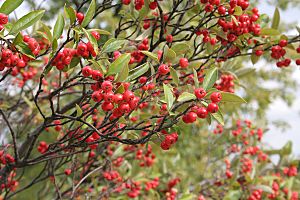Aronia arbutifolia facts for kids
Quick facts for kids Aronia arbutifolia |
|
|---|---|
 |
|
| Scientific classification | |
| Genus: |
Aronia
|
| Species: |
arbutifolia
|
| Synonyms | |
|
Synonymy
Mespilus arbutifolia L. 1753
Adenorachis arbutifolia (L.) Nieuwl. Aronia densa Carrière Aronia × densiflora Spach Aronia glabrescens Spach Aronia nigra Dippel Aronia pubens Spach Aronia pumila (Neumann) M.Roem. Aronia pyrifolia (Lam.) Pers. Crataegus pyrifolia Lam. Hahnia arbutifolia (L.) Medik. Photinia pyrifolia (Lam.) K.R.Robertson & J.B.Phipps Pyrus arbutifolia (L.) L.f. Pyrus densiflora (Spach) Steud. Pyrus pumila Neumann ex Tausch. Sorbus arbutifolia (L.) Heynh. Sorbus densiflora (Spach) Heynh. |
|
The red chokeberry, known scientifically as Aronia arbutifolia, is a type of shrub found in North America. It belongs to the rose family, which also includes many fruits like apples and strawberries.
This plant is native to eastern Canada and much of the eastern and central United States. You can find it growing from eastern Texas all the way to Nova Scotia. It also grows inland in places like Ontario, Ohio, Kentucky, and Oklahoma.
Red chokeberry is a shrub that branches out and forms clumps. It grows new stems from its roots, helping it spread. Its flowers are usually white or pink. These flowers later turn into bright red fruits. Many people find these fruits to have a very tart or bitter taste.
Contents
What is Red Chokeberry?
The red chokeberry is a hardy plant. It is a type of shrub, which means it is a woody plant smaller than a tree. It can grow to be quite tall, sometimes reaching up to 10 feet (3 meters) high.
This plant is known for its beautiful fall colors. Its leaves turn a vibrant red, making it a popular choice for gardens. It can grow in many different types of soil.
Plant Features
The red chokeberry has several interesting features. These include its leaves, flowers, and fruits. Each part plays a role in the plant's life cycle.
Leaves and Stems
The leaves of the red chokeberry are simple and oval-shaped. They are usually dark green during the summer. In the autumn, they change to bright shades of red and purple. This makes the plant very noticeable in the landscape.
The stems of the red chokeberry are reddish-brown. They grow upright and can form dense clumps. New stems often sprout from the roots, helping the plant spread out over time.
Flowers and Berries
In the spring, the red chokeberry produces small, pretty flowers. These flowers are typically white or light pink. They grow in clusters, making the shrub look very attractive when in bloom.
After the flowers fade, small, round fruits begin to form. These fruits are called berries, and they ripen in late summer or early fall. They turn a bright, glossy red color. While they look appealing, they are known for their very tart taste. This is why they are called "chokeberries."
Where Red Chokeberry Grows
The red chokeberry is native to a large area of North America. It thrives in many different environments. Understanding its natural habitat helps us know where it can be found.
Native Range
The plant's native range covers a wide region. It is found in eastern Canada, including Nova Scotia and Ontario. In the United States, it grows from the eastern parts of Texas all the way up the East Coast.
It also extends westward into central states like Ohio, Kentucky, and Oklahoma. This wide distribution shows that the red chokeberry can adapt to various climates and soil conditions.
Habitat and Growing Conditions
Red chokeberry can grow in many different places. It is often found in wet areas, like swamps and bogs. However, it can also grow in drier, upland areas.
It prefers full sun but can tolerate some shade. This adaptability makes it a versatile plant. It can be found in forests, along roadsides, and in open fields.
Uses of Red Chokeberry
Even though the berries are tart, red chokeberry has some uses. It is often planted for its beauty and for wildlife.
Gardening and Landscaping
Because of its attractive flowers and brilliant fall foliage, red chokeberry is a popular plant for landscaping. People often plant it in gardens or along property lines. It can be used to create hedges or as a standalone shrub.
It is also a low-maintenance plant. This means it does not need a lot of special care once it is established. It is also resistant to many common plant diseases.
Wildlife and Food
The berries of the red chokeberry are an important food source for wildlife. Many birds and small animals eat the berries, especially in winter when other food is scarce.
While the berries are very tart to eat raw, they can be used in cooked foods. Some people use them to make jams, jellies, or juices. Cooking the berries can reduce their tartness. They are also known to be rich in vitamins and antioxidants.
See also
 In Spanish: Aronia arbutifolia para niños
In Spanish: Aronia arbutifolia para niños

